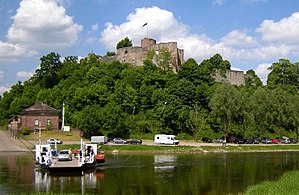Polle castle ruins
| Polle castle ruins | ||
|---|---|---|
|
Polle castle ruins on the Weser |
||
| Alternative name (s): | Eversteiner Burg near Polle, Burg Polle | |
| Creation time : | first mentioned in 1285 | |
| Castle type : | Hilltop castle | |
| Conservation status: | ruin | |
| Place: | Pollen | |
| Geographical location | 51 ° 53 '50.4 " N , 9 ° 24' 25.4" E | |
| Height: | 112.5 m above sea level NHN | |
|
|
||
The Polle castle ruin is the ruin of a hilltop castle on an approximately 25 meter high cliff directly on the Weser above the municipality of Polle in the Holzminden district in Lower Saxony .
The facility, first mentioned in 1285 as "Everstein Castle", was the seat of the Everstein Counts . It was also called "Eversteiner castle in Polle," is not to be confused with the southern 10 kilometers Castle Everstein the ridge Castle Hill .
Location and building description
The castle is situated on a rocky elevation east of the Weser near a distinctive bend in the river . The summit drops steeply on three sides as a rock. The castle complex consisted of an upper castle and a lower castle , of which essentially only remnants of the curtain wall have been preserved. From the upper castle there are remains of several buildings and wall remains of the gate tower as well as the outer walls of the residential buildings. There is also an approximately 20 m high, climbable round tower , which served as a watch tower and keep . An underground passage leads from it to the castle fountain . In the past, the castle was additionally secured with walls, in some cases with double moats and drawbridges and ramparts. The ruin can be visited.
history
Polle Castle is believed to have been built around the year 1200. It is considered one of the ancestral castles of the Everstein counts . At the time of its first documented mention in 1285, it was the seat of the Everstein Counts, who, as supporters and relatives of the Staufers , had lost their Everstein Castle to the Welfs near Amelungsborn Monastery in 1284 . In 1407, Heinrich I, as Duke of Braunschweig-Lüneburg, took Polle Castle in the course of the Everstein feud with a force of 13,000 men. In 1408, Count Hermann VII from Everstein handed over his county to the Brunswick dukes, so that Polle Castle finally fell to the Guelphs.
During the Thirty Years War , the army led by Johann T'Serclaes von Tilly besieged Polle Castle and plundered it after the conquest in 1623. The town of Polle also suffered damage. In 1641 Swedish troops shot up the castle with their guns, which burned out. The castle was not captured by the Swedes. After the end of the war, the lower castle was rebuilt from 1656, while the upper castle was left as a ruin. An office building in the style of the Weser Renaissance was built in the lower castle , which was destroyed in the heavy fighting for Polle at the end of the Second World War. Only the Renaissance portal with its coat of arms has been preserved from the building.
An extensive renovation of the castle complex took place from 1984 to 1988. Between 2007 and 2009 archaeological excavations took place on the castle grounds , the finds of which are in the castle museum. Several times a year cultural events take place in the castle courtyard , including performances of the fairy tale Cinderella , as Polle is the alleged “home” of the Cinderella.
Around 1650 as a ruin after the Thirty Years War
Around 1760, on the right the office building from the middle of the 17th century.
(Drawing by Pascha Johann Friedrich Weitsch )Main castle with a round keep
Renaissance portal adorned with coat of arms
literature
- Ernst Andreas Friedrich : Die Burgruine Polle , p. 152, in: If stones could talk. Volume IV, Landbuch-Verlag, Hannover 1998, ISBN 3-7842-0558-5 .
Individual evidence
- ↑ Breathtaking view of the Weser: Polle castle ruins. July 28, 2017, accessed January 12, 2020 .
Web links
- Entry by Stefan Eismann on Polle Castle ruins in the scientific database " EBIDAT " of the European Castle Institute
- Poller Castle in the Lower Saxony Monument Atlas
- Polle Castle at www.burgen.de
- Reconstruction drawing of the castle entrance in its medieval state
- Reconstruction drawing of the castle in the medieval state from a bird's eye view
- Description of the castle ruins and the coat of arms of the Renaissance archway
- Photographs of the Polle castle ruins at the Photo Archive Photo Marburg







